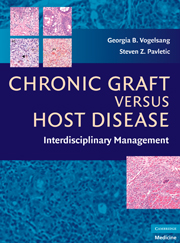Book contents
- Frontmatter
- Contents
- List of Contributors
- Preface
- PART I GENERAL PRINCIPLES
- 1 Historical Aspects of Chronic Graft versus Host Disease
- 2 The Pathophysiology of Acute Graft versus Host Disease
- 3 Pathophysiology of Chronic Graft versus Host Disease
- 4 Animal Models of Chronic Graft versus Host Disease
- 5 Incidence and Trends
- 6 Clinical Manifestations and Natural History
- 7 Risk Factors and Predictive Models for Chronic Graft versus Host Disease
- 8 Biomarkers in Chronic Graft versus Host Disease
- PART II CLINICAL MANAGEMENT
- PART III ORGAN SITE OR SYSTEM-SPECIFIC MANIFESTATIONS
- PART IV SPECIAL CONSIDERATIONS IN CHRONIC GVHD
- Index
- Plate section
6 - Clinical Manifestations and Natural History
from PART I - GENERAL PRINCIPLES
Published online by Cambridge University Press: 26 August 2009
- Frontmatter
- Contents
- List of Contributors
- Preface
- PART I GENERAL PRINCIPLES
- 1 Historical Aspects of Chronic Graft versus Host Disease
- 2 The Pathophysiology of Acute Graft versus Host Disease
- 3 Pathophysiology of Chronic Graft versus Host Disease
- 4 Animal Models of Chronic Graft versus Host Disease
- 5 Incidence and Trends
- 6 Clinical Manifestations and Natural History
- 7 Risk Factors and Predictive Models for Chronic Graft versus Host Disease
- 8 Biomarkers in Chronic Graft versus Host Disease
- PART II CLINICAL MANAGEMENT
- PART III ORGAN SITE OR SYSTEM-SPECIFIC MANIFESTATIONS
- PART IV SPECIAL CONSIDERATIONS IN CHRONIC GVHD
- Index
- Plate section
Summary
INTRODUCTION
Chronic graft versus host disease (cGVHD) is a clinical syndrome characterized by pleomorphic manifestation occurring over time with periods of exacerbation of acute manifestations or development of new clinical features in previously uninvolved or involved organs. cGVHD can affect multiple sites (Figure 6.1) and resembles manifestations of scleroderma, Sjogren syndrome, wasting syndrome, primary biliary cirrhosis, bronchiolitis obliterans, immune cytopenias, and chronic immunodeficiency disorders. The etiology of the variable phenotype of cGVHD is poorly understood and may depend on the type and intensity of the inflammatory and cellular process caused by immune dysregulation associated with cGVHD. Immune mechanisms leading to the diverse clinical manifestations of cGVHD have not been elucidated. Autoimmunity is thought to be involved because of the clinical similarities between cGVHD and autoimmune diseases. Dysfunctional T-cell selection in the thymus leading to a population of TH2 self (recipient)-reactive T cells and differences in TH1 and TH2 responses by donor cells to recipient alloantigens may also play a role in pathogenesis. Recent studies reported that regulatory T cells (Treg) are major determinants of a persistent immune imbalance that may result in cGVHD.
- Type
- Chapter
- Information
- Chronic Graft Versus Host DiseaseInterdisciplinary Management, pp. 56 - 69Publisher: Cambridge University PressPrint publication year: 2009
- 3
- Cited by



